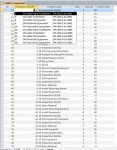I've a design issue, yet again. I've two tables with many-to-many relationship, where number of activities could be done on an equipment, and similarly equipment might also be treated under certain activities. Junction table between those tables comes up with different set of requirements for each type of activity, on each equipment.
In attachment 1, I've created my situation where I have Activity and Equipment table and the Junction table between them. Now there are several different kind of activities and each activity appears to have a different set of attributes for the Junction table. This is what I've tried to described in attachment 2.
If I try to create a different Junction Table for each different activity/equipment combination, then there will be several Junction Tables connecting to the same Activity and Equipment table. Will it be a correct approach according to database design rules??
I am wondering what are the other possibilities to deal with such situation, if above approach is not correct?? I've tried several approaches but in every approach there is something which makes me turn it down.
Each activity is later saved in History Table on daily basis to get the progress graph, as hinted in attachment 1. This will later be verified weekly from history table and any excess or missed quantity will be adjusted accordingly. I'm mentioning this because when it'll be verified, I'll then need to go back and make modifications in relevant tables via some automatic procedure according to adjusted amount. I'm mentioning this because maybe it'll have an impact in a way i am trying to design a database.
I'm really in need of bit of a quick help here with very limited time left in project completion. Any help will be appreciated.
Thank you,
K
In attachment 1, I've created my situation where I have Activity and Equipment table and the Junction table between them. Now there are several different kind of activities and each activity appears to have a different set of attributes for the Junction table. This is what I've tried to described in attachment 2.
If I try to create a different Junction Table for each different activity/equipment combination, then there will be several Junction Tables connecting to the same Activity and Equipment table. Will it be a correct approach according to database design rules??
I am wondering what are the other possibilities to deal with such situation, if above approach is not correct?? I've tried several approaches but in every approach there is something which makes me turn it down.
Each activity is later saved in History Table on daily basis to get the progress graph, as hinted in attachment 1. This will later be verified weekly from history table and any excess or missed quantity will be adjusted accordingly. I'm mentioning this because when it'll be verified, I'll then need to go back and make modifications in relevant tables via some automatic procedure according to adjusted amount. I'm mentioning this because maybe it'll have an impact in a way i am trying to design a database.
I'm really in need of bit of a quick help here with very limited time left in project completion. Any help will be appreciated.
Thank you,
K






